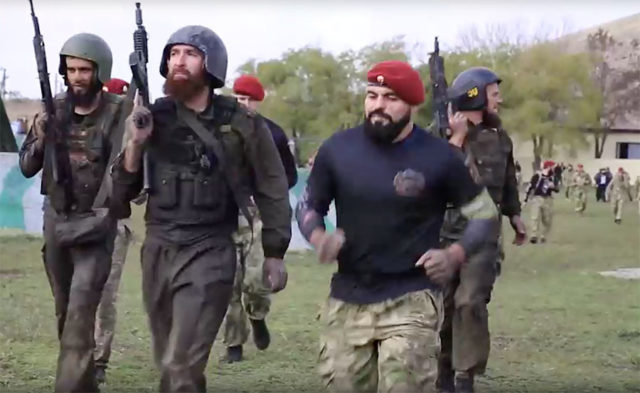
Chechen and Russian Special Forces Clash Over Insignia
Publication: Eurasia Daily Monitor Volume: 18 Issue: 165
By:

Ethnic-Chechen and ethnic-Russian members of a special forces unit clashed at the Tambukan training center, in Stavropol Krai, in mid-October. The row took place amidst trials these service members were undergoing to receive the honor of wearing the crimson (maroon) beret. The crimson beret symbolized high status among the special forces of the Russian Ministry of Interior in the past, and today it represents the same distinction for troops of the Russian National Guard (Rosgvardia; the successor of the Interior Ministry Troops, created in 2016—see EDM, April 7, 2016). During a long march, one of the stages that must be completed to be eligible to don the beret, friends of some candidates from Chechnya reportedly gave them rides in their cars. The current holders of crimson berets resented this, which led to a massive fistfight. Igor Semilyak, the head of the Main Directorate of Rosgvardia Special Forces, was reportedly forced to intervene in the conflict personally. After the incident, several people were allegedly taken off the course but handed the berets anyway. In response, previous holders of the crimson berets—special forces troops of the 604th Red Banner Special Purpose Center “Vityaz”—decided to switch to the statutory caps as a sign of protest (Gazeta.ru, October 17).
A spokesman for the Rosgvardia troops, Valery Gribakin denied any fighting or protests had broken out among the special force personnel. Gribakin explained that the crimson beret “is not taken off even when facing the enemy, let alone as a sign of disagreement with the outcome of the competition.” The crimson beret is the highest form of distinction for the most highly trained Rosgvardia special forces in Russia. It provides no additional benefits but is a source of pride for the owner and a symbol of the “Vityaz” group fighters. It is awarded only after the passage of difficult qualification tests. Their main part is comprised of a ten-kilometer cross-country run, overcoming obstacles in extreme conditions; the participants complete it while wearing a full combat outfit and carrying their weapons. After the march, the candidates have to fight in several hand-to-hand sparring sessions (Izvestia, October 18).
Following the incident, the founder of the tradition, Sergei Lysyuk, stated that the Council of Crimson Berets would investigate the situation at the Tambukan training center (TASS, October 17). Soon, Lysyuk reported that the information about fights and fraud at the trials for the crimson berets in the Stavropol region was not confirmed (TASS, October 18). Nevertheless, videos depicting skirmishes during the special forces trials proliferated on the internet (YouTube, October 18). Lysyuk also confirmed that Chechen leader Ramzan Kadyrov’s relative was removed from the trials.
Several security officers and a reserve colonel warned that Ramzan Kadyrov would be seen extremely negatively in the Russian army if he did not respond to the scandal and did not punish the perpetrators (Kavkazsky Uzel, October 23). However, within days, Chechen special forces commanders Anzor Bisaev and Saidi Lorsankayev received Mercedes-Benz cars from the Ahmad Kadyrov Regional Public Foundation in Chechnya for obtaining crimson berets (RIA Novosti, October 22). Overall, seven participants from Chechnya took part in the trials. A well-known critic of Kadyrov, Tumso Abdurakhmanov stated that the cheating during the crimson beret trials confirmed Chechen elite troops’ lack of professionalism (Kavkazsky Uzel, October 25).
For Kadyrov, the Chechen special forces have always been a matter of great pride. Even though formally the National Guard is under the direct command of Moscow, its local Chechen units are de facto under the control of the ruler of Chechnya. This happens due to several factors but primarily because of the unspoken contract between Moscow and Grozny, whereby the Kremlin has established a semblance of indirect rule in Chechnya. The Chechen head was granted a significant degree of autonomy in exchange for crushing the armed pro-independence movement in the republic. As part of this overarching agreement, Kadyrov is allowed to have his own special forces. To keep his control over them, Kadyrov appoints close associates to lead the Rosgvardia in Chechnya. These units are manned only by Chechens, unlike other units in the Russian Federation where the Rosgvardia detachments tend to be made up of mixed populations.
The Russian National Guard was established in 2016 out of the Russian Interior Ministry Troops and several special police forces, such as OMON, SOBR and others. The Rosgvardia units are organized into military districts. These districts are distinct from those of the Russian Armed Forces. Namely, the boundaries of the National Guard districts largely coincide with the Russian federal district boundaries, so there are Southern and North Caucasian districts of Rosgvardia. In Chechnya and Ingushetia, the National Guard consists exclusively of locally recruited service members; whereas, in other republics of the North Caucasus, service members transferred from other regions also serve in the regional units of the agency. Despite being a locally recruited force, Rosgvardia troops, along with other military and police personnel in Chechnya, are reportedly much disliked by the general population. Still, for many local youths, joining Russian (para)military units and serving Kadyrov is one of the few ways to achieve a better way of life (Kavkazsky Uzel, October 19).
The latest scandal spotlighted the muted cleavages between the Chechen and Russian service members, and the way it was handled incidentally showcased the administrative sway that Ramzan Kadyrov enjoys within the Russian government. While the Kremlin certainly favors Chechnya’s ruler, the special treatment of Chechens fuels resentment among the Russian military establishment, which is likely to manifest itself in new inter-ethnic conflicts in the future.



